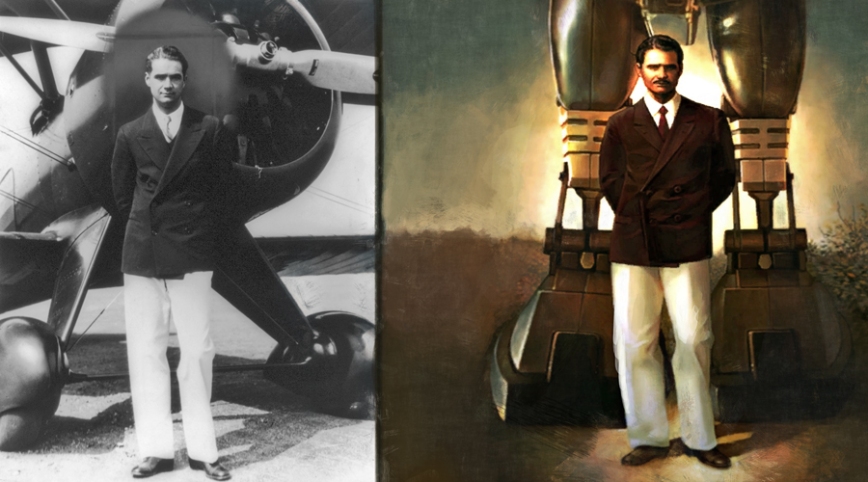The House always wins.
A goodly number of “Fallout” fans play through “New Vegas” without ever noticing the incredibly striking parallels between the Vegas Strip’s monolithic figure – the reclusive pragmatist Robert Edwin House – and the real-world filmmaker and aviation magnate Howard Hughes. Looking at the image above, it’d be a stretch to call it a coincidence. Mr. House’s biography draws heavily on the life and career of Hughes in a wonderful homage to mid-century America.
Let’s take a look at a brief breakdown of their respective biographies.
– – –
Robert House: Born to a wealthy tool magnate. He was orphaned at an early age and was cheated out of his inheritance. Despite this setback, he attended the Commonwealth Institute of Technology (inspired by MIT) and founded RobCo Industries, a robot manufacturing empire that plays a significant role throughout the “Fallout” series. His technical genius and prolific business skills made him a leading figure in aerospace engineering, Vegas Casinos & entertainment, and even reacquired the H&H Tool Company from his half-brother.
Mr. House survives the nuclear apocalypse in a cryogenic chamber of his own design. After two hundred years of preservation, however, he cannot risk leaving his isolation chamber; exposure to outside contaminants would prove deadly. He rules the whole of the New Vegas Strip remotely, using an army of security robots (securitrons) and has brokered treaties with regional tribes, who he has employed to repair and re-open The Strip.
In his corporate portrait (pictured above) we see Mr. House standing in front of one of his greatest robotic achievements, Liberty Prime, a building-sized robot designed to assist American troops in fighting the communist Chinese. Liberty Prime, known to anybody who has played “Fallout 3”, is central to the game’s plot. This portrait is a fun hint at the development and history of Liberty Prime that we don’t see until the follow-up game, “Fallout: New Vegas.”
Howard Hughes: Born to a successful inventor and businessman who founded the Hughes Tool Company in 1909. He demonstrated high aptitude in science and technology at a very young age. In particular, he become interested in engineering, building Houston’s first “wireless” radio transmitter at age 11. He used spare parts from a steam engine to make a motorized bicycle, took his first flying lesson at 14, and attended math & aeronautical engineering courses at Cal-Tech.
Both of Howard Hughes’ parents died when he was a teenager – his mother from complications of an ectopic pregnancy and his father from a heart attack. Hughes took his inheritance and became a Hollywood tycoon in the 1920s before forming the Hughes Aircraft Company. He broke several world air speed records, acquired and expanded Trans World Airlines, and revolutionized commercial air travel.
In later life, he began to evince symptoms of mental illness, including obsessive-compulsive disorder. He is remembered for eccentric behavior, impulsive spending, and an unhealthy obsession with germs. In November of 1966, Hughes traveled to Las Vegas and moved into the Desert Inn. He refused to leave the hotel and decided to purchase it in order to avoid conflict with the owners; he made the ninth-floor penthouse his personal residence. He subsequently purchased The Castaways, New Frontier, The Landmark Hotel and Casino, and The Sands.
He would be isolated for weeks at a time, handled common items with tissues to avoid contamination, and become obsessed with underground nuclear testing at he Nevada Test Site. He severely disapproved of nuclear testing, fearing exposure to radiation. Hughes is reported to have died on April 5, 1976, although no definitive record exists. He had suffered from severe malnutrition, likely the result of his obsession with microbes and infection, and a later autopsy stated kidney failure as the cause of death.
– – –
Wealthy parents, tool companies, aerospace engineering, eccentricity, isolation, and fear of contamination. The script writers at Bethesda Game Studios paid strict attention to detail, straight down to the Howard Hughes initials for the game’s H&H Tool Company. Beyond that, Mr. House has a security robot named Jane; we later discover that Mr. House has an unusual attachment to the automaton. This computer companion is likely a reference to Jane Russell, a starlet who was under contract to Howard Hughes for a brief period of time and was also one of his lovers.
Mr. House also has a peculiar hobby collecting snow-globes. There is a good chance that this is a reference to the snow-globe in the opening scene of Orson Wells’ classic film “Citizen Kane.” While not one of Hughes’ films, it is considered an undeniable classic contemporaneous with Hughes’ own cinematic achievements. Additionally, “Citizen Kane” took it’s inspiration from another business tycoon: William Randolf Hearst.
Certainly, much more could be scribbled down about these two – and believe me, I am deeply fascinated with William Randolf Hearst – but these are the major points. It is this level of creativity, appreciation of history, and flat-out whimsy that makes these games so phenomenally fun, and the franchise so unprecedentedly successful. I’ll be keeping my eyes peeled for other interesting tidbits during my next play-through.
Cheers.
